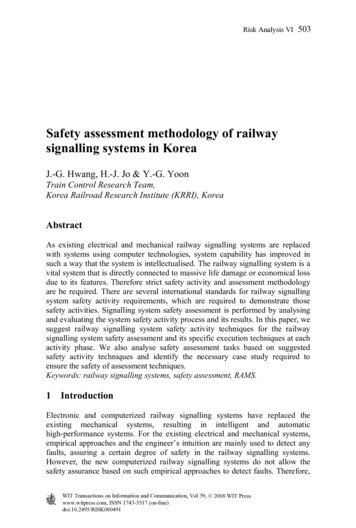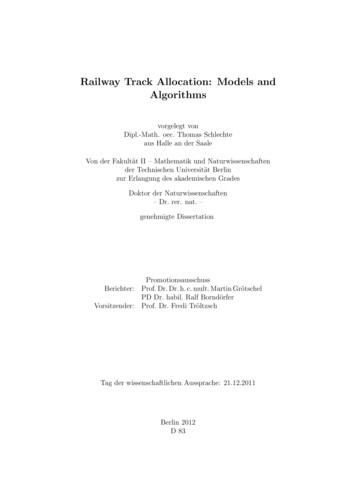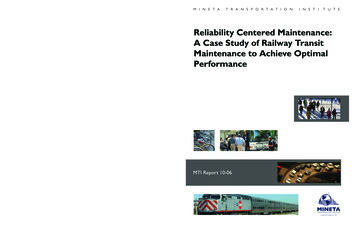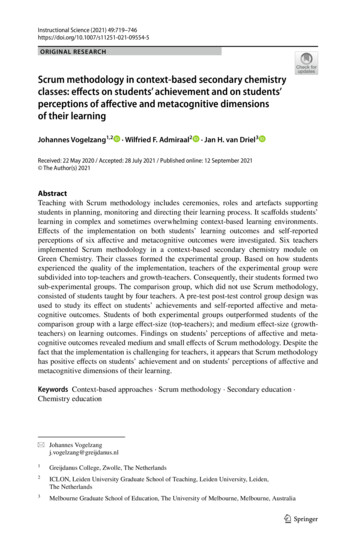
Transcription
Risk Analysis VI503Safety assessment methodology of railwaysignalling systems in KoreaJ.-G. Hwang, H.-J. Jo & Y.-G. YoonTrain Control Research Team,Korea Railroad Research Institute (KRRI), KoreaAbstractAs existing electrical and mechanical railway signalling systems are replacedwith systems using computer technologies, system capability has improved insuch a way that the system is intellectualised. The railway signalling system is avital system that is directly connected to massive life damage or economical lossdue to its features. Therefore strict safety activity and assessment methodologyare be required. There are several international standards for railway signallingsystem safety activity requirements, which are required to demonstrate thosesafety activities. Signalling system safety assessment is performed by analysingand evaluating the system safety activity process and its results. In this paper, wesuggest railway signalling system safety activity techniques for the railwaysignalling system safety assessment and its specific execution techniques at eachactivity phase. We also analyse safety assessment tasks based on suggestedsafety activity techniques and identify the necessary case study required toensure the safety of assessment techniques.Keywords: railway signalling systems, safety assessment, RAMS.1IntroductionElectronic and computerized railway signalling systems have replaced theexisting mechanical systems, resulting in intelligent and automatichigh-performance systems. For the existing electrical and mechanical systems,empirical approaches and the engineer’s intuition are mainly used to detect anyfaults, assuring a certain degree of safety in the railway signalling systems.However, the new computerized railway signalling systems do not allow thesafety assurance based on such empirical approaches to detect faults. Therefore,WIT Transactions on Information and Communication, Vol 39, 2008 WIT Presswww.witpress.com, ISSN 1743-3517 (on-line)doi:10.2495/RISK080491
504 Risk Analysis VIIEC (International Electrotechnical Commission) requires more rigorous safetyactivities to assure the safety of the railway signalling systems [1,2,5,7]. Inaddition, such safety activities have to be evaluated by an ISA (IndependentSafety Assessor) in order to assure a certain degree of safety in the railwaysignalling systems.The safety activity requirements for railway signalling systems wereestablished as the international standards by the IEC. Further, the IEC standardsdescribe the documentation requirements necessary to demonstrate such safetyactivities. The safety assessment of the railway signalling systems is done byperforming safety activities and analysing/evaluating the results [3,4,6].Therefore, it is necessary to review and analyse the safety activity system andtools appropriate for railway signalling systems, in order to establish thetechniques for safety assessment of the railway signalling systems. In Korea,many researchers have investigated the methodologies to evaluate the safety ofthe railway signalling systems, which will be discussed in this study.2Overview of safety assessment technology for railwaysignalling systemsThe safety assessment of the railway signalling systems is performed throughsafety activities and verification of results from such activities. Therefore,analysis of the safety assessment of railway signalling systems is very importantin developing the safety assessment technology. Analysis of the safetyassessment of railway signalling systems was performed through investigationand analysis of international standards and technical advice from foreign safetyassessment consultants.2.1 What is a safety assessment?The former European safety-related standards on railway systems weretransformed into the international standards by the IEC, which require the safetyactivity and assessment for the railway signalling systems. In foreign countries,the manufacturers of the railway signalling systems also perform the safetyactivities according to the international standards. In addition, there areindependent safety assessors to perform the safety assessment of the railwaysignalling systems according to the IEC standards. In Korea, such internationalstandards have recently been introduced, making people recognize the need forsafety activities and assessment. As a result, some research programs on suchsafety activities and assessment have been initiated.In general, the safety assessment of the railway signalling system isconducted by the ISA (Independent Safety Assessor). The basic systemrequirements are determined by the purchasers and the operators, but the safetyrequirements other than system function and performance requirements have tocomply with IEC 62278, IEC 62279, and IEC 62425 in European countries. Suchsafety-related standards provide the requirements for safety approval proceduresand supporting documents to assure the safety of the railway systems. Amongthose standards, IEC 62278 is a framework standard that defines basic conceptsWIT Transactions on Information and Communication, Vol 39, 2008 WIT Presswww.witpress.com, ISSN 1743-3517 (on-line)
Risk Analysis VI505and safety procedures for railway signalling systems as well as overall railwaysystems. In addition, this standard describes the definition of SIL (SafetyIntegrity Level) and IEC 62425 provides detailed requirements for SIL. Theactivities to be performed by the manufacturers and the assessors are specified inIEC 62425.2.2 Safety activity and the safety assessment systemFig. 1 shows the risk-based safety activity and safety assessment process for therailway signalling system. The assessment system consists of system definition,PHA (Preliminary Hazard Analysis), HIA (Hazard Identification and Analysis),risk analysis and SIL allocation. The safety assessment of the railway signallingsystem is a process of verifying if various required documents are prepared, ifsuch documents are appropriate, and if the identified hazards are minimized to anacceptable level through safety activities. Therefore, in performing the safetyassessment, it is necessary to analyse the safety activity system for the railwaysignalling system and the documents prepared through such safety activity andtheir quality level. In this study, some methodologies were selected according tothe system shown in figure 1; PHA for hazard analysis at step ①, FMEA andHAZOP for hazard identification and FTA (and ETA as a supplementary step, ifnecessary) for hazard analysis at step ②, and BP-risk method and SIL allocationmethod based on THR derived from BP-risk according to SIL matrix (IEC62278).Among several IEC standards regarding the safety of the railway system, theIEC 62425 standard defines the safety assessment as the analytical process witha view to determining whether a system satisfies specific requirements andFigure 1:Safety activity and the safety assessment system.WIT Transactions on Information and Communication, Vol 39, 2008 WIT Presswww.witpress.com, ISSN 1743-3517 (on-line)
506 Risk Analysis VIwhether the system operates as intended. Foreign safety assessmentorganizations perform the safety assessment activities for the railway signallingsystems according to the definition of the IEC 62425 standard. From the analysisof various standards regarding the safety of the railway system, investigation ofprior research activities and technical advice from foreign safety assessmentorganizations, the objectives in performing the safety assessment of the railwaysignalling systems can be summarized as follows:- Verifying if the system requirements are adequate- Verifying if the system requirements, codes, and standards are compliedwith- Verifying if system risks are removed or reduced to acceptable levels- Analysing and verifying the master safety plan- Analysing the hazards log2.3 Safety assessment processAs described above, the safety assessment of the railway signalling systems is toverify if a system is able to accomplish the intended purposes and if all potentialhazards are identified and removed or reduced to an acceptable level. Suchremoval or reduction of those potential hazards can be confirmed only byverifying the adequacy of measures for removal or reduction and the realizationand performance of the functional system requirements. In other words, serioushazards may be mistakenly omitted or underestimated in the process ofidentifying and controlling the potential hazards. Such problems may be solvedto some degree through the safety management.S tate m en t : S yste m is com p lia nt and fit for its inten ded p urp oseA ss es sm e n to f q u alitym anagem entA s ses sm en to f sa fetym an ag em en tFigure 2:A ss ess m e n to f te ch n ic alan dfu n c tio n alsa fetyAssessment tasks.In addition, the project system will not be designed and made as only onesystem to be tested, but it will be made and operated for the manufacturer’scontinuous assessment based on the same procedures. Therefore, it is importantthat the system manufacturers assure that the future systems have the samequality as that of the system under test and assessment. In performing the safetyWIT Transactions on Information and Communication, Vol 39, 2008 WIT Presswww.witpress.com, ISSN 1743-3517 (on-line)
Risk Analysis VI507assessment of the railway signalling systems, verification and validation of suchquality control system are highly important. In other words, the safetyassessment of the railway signalling system comprises the assessment of thetechnical and functional safety as well as the assessment of system quality andsafety management. Accordingly, as shown in fig. 2, the safety assessment of therailway signalling systems consists of the assessment of technical and functionalsafety, the assessment of quality management, and the assessment of safetymanagement.3Definition of safety assessment of railway signalling systemsAs described above, the safety assessment of the railway signalling systemsconsists of the assessment of quality management, the assessment of safetymanagement, and the assessment of technical and functional safety. The safetyassessment in these three aspects is intended to verify if appropriate safetyactivities and procedures are complied with and determine whether the identifiedhazards are removed or reduced to acceptable levels.Prior to the safety assessment, the master safety plan for the project systemhas to be evaluated for its adequacy and the master document for safety measuressummarizing the safety activities and the results has to be verified forcompliance with the master plan. Therefore, in performing the safety assessmentof the railway signalling systems, checks are carried out to ensure that theplanned project activities were performed according to the practices andprocedures specified in the safety plan. The safety assessment through analysisand verification of safety plans, safety requirements, the master document forsafety measures, and other related documents is called the “Analysis AssessmentApproach”, which is an essential part of the safety assessment of the railwaysignalling systems.This analysis assessment approach can be divided into two assessmentactivities; assessment of safety management procedures and practices assessmentof whether the identified hazards relating to the relevant railway signallingsystem project are removed or reduced to acceptable levels through the designand manufacture processes. Verification and validation of safety managementpractices, quality control, and organizational structure can be done throughexamination of documents. However, analytical procedures and additional testsare required to verify whether the identified hazards are actually removed orreduced to acceptable levels. The safety of the railway signalling system can beverified and assessed through these activities. In addition, for the analysisassessment approach, the system safety requirements will be reviewed, thespecifications will be evaluated for their adequacy in terms of risk control, andthe system will be assessed to verify whether it is in compliance with the safetyrequirements specification. In short, the safety assessment of the railwaysignalling system begins with the review and verification of the hazards log,safety plan, safety requirements specification, and other documents. In addition,analysis of the master document for safety measures may lead to the request forformal tests to verify the functions. If necessary, additional tests in challengedWIT Transactions on Information and Communication, Vol 39, 2008 WIT Presswww.witpress.com, ISSN 1743-3517 (on-line)
508 Risk Analysis VIconditions may be required to verify the safety of the system. Such assessmentcan be called the “Test Assessment Approach”.In short, the safety assessment of the railway signalling system consists of theanalysis assessment approach and the test assessment approach. These twoapproaches lead to the hazard closure verification, resulting in final safetyapproval. In other words, when the safety assessment is completed through theseapproaches and the system is finally approved, it means that the identifiedhazards for the railway signalling system are removed or reduced to acceptablelevels. This safety assessment process is summarized in fig. 3.Figure 3:4Safety assessment process for railway signalling systems.Proposed methodology for safety assessment of railwaysignalling systemsAs explained in the above section, the safety assessment of the railway signallingsystems consists of analysis assessment and test assessment. Most safetyassessment is concerned with the analysis of the safety plan, the requirementsdocument, the master document for safety measures, and other documents. Afterthe analysis assessment, the test assessment for additional verification orexamination is performed to assess the safety of the railway signalling system. Inaddition to such classification of two approaches (analysis assessment and testassessment), another classification is possible to reflect the actual assessmentactivities. In this study, the two-step safety assessment is proposed on the basisof the analysis of assessment activities, practices, and procedures.The safety assessment at the step of requirements definition (basic step) is todefine the scope of the safety assessment activities and to develop the safetyassessment plan after analysis of the safety plan and the safety requirementsdocuments. The main purpose of this step is to analyse the safety requirementsWIT Transactions on Information and Communication, Vol 39, 2008 WIT Presswww.witpress.com, ISSN 1743-3517 (on-line)
Risk Analysis VI509specification, system functions and operating environments and to develop thesafety plan, including the safety assessment items and criteria, applicable to thewhole safety assessment process. At the execution step (detail step), actual safetyassessment activities are conducted. Quality control, safety management, andfunctional and technical safety are assessed according to the safety assessmentplan developed at the basic step. All documents, including the master documentfor safety measures, are used for safety assessment. The risk minimizationmeasures for individual hazards, expected results, and tests are performed at thisstep to verify whether the identified hazards are removed or reduced toacceptable levels (Hazards Closure Verification).Requirements Phase‘Concept Phase’Drawing upAssessment PlanAssessment oftechnical andfunctional safetyprinciplesAssessment ofRequirements andplanning documentsSafety AuditStatus AssessmentReportFigure 4:Implementation Phase‘Detailed Phase’Detailed TechnicalAssessmentAudits (safetymanagement, Datapreparation,configuration,competence and testing)Fault inserting tests andfunctional tests on siteor representative testsiteFinal Assessment ReportAssessment activities.The test and assessment step consists of the performance tests, safety tests,and field tests. The safety tests are to test the design and modules for safetyfunctions of a system. For example, the fault insertion test is the representativetest in the safety tests. The safety tests are classified into special safety tests andsafety system tests.The test assessment is highly important in performing the safety assessmentof the railway signalling systems. There are no standards providing test methodsfor safety assessment. Such methods may vary depending on the projectcircumstances, types of documents, and degree of safety and quality. Fig. 5shows the relationship of safety activities and safety assessment process. Thesafety activity flow and steps are provided in the left part of the figure, while thesafety assessment process and procedures are explained in the right part. Asshown in the figure, the safety activity mainly consists of the risk analysis stepWIT Transactions on Information and Communication, Vol 39, 2008 WIT Presswww.witpress.com, ISSN 1743-3517 (on-line)
510 Risk Analysis VIand the risk control step and the safety assessment based on the safety activity isdivided into the requirements definition step and the execution step. “DataAnalysis” represents the requirements definition step at which the safetyassessment plan is developed. The execution step is further divided into “SafetyAnalysis Assessment” and “Test Assessment”.Figure 5:Safety assessment according to safety activity.In this study, the safety assessment process and steps for the railwaysignalling systems are proposed and the applicable technologies, templatesrequired at individual steps, assessment guidelines, specifications fordevelopment of the software safety assessment instrument, and others areprovided as described in fig. 5. In particular, the list of documents to be analysedand verified in the safety assessment of the railway signalling systems and thechecklist templates to be used in two safety assessment steps are provided here.5ConclusionThe need for safety activity for railway signalling systems in compliance withinternational standards has been increasingly highlighted. In addition, the needfor developing the validation and assessment technologies has been increased.Accordingly, this study proposes the methodology for safety assessment basedon the analysis of requirements prescribed in international standards regardingthe railway signalling systems.In addition, the techniques and procedures for the proposed safety assessmentprocess were investigated. For example, major hazards for the railway signallingsystems in Korea were listed and analysed and various templates, such as theWIT Transactions on Information and Communication, Vol 39, 2008 WIT Presswww.witpress.com, ISSN 1743-3517 (on-line)
Risk Analysis VI511safety requirements template and the assessment plan template, were developed.Further, the guidelines on preparation of the master document for safetymeasures and on software safety assessment are under development. Moreover,the research program is on-going to investigate the strategy to apply the morequantitative BP (best practice) method for list analysis and assessment to theKorean railway signalling systems.References[1] IEC 62278, “Railway Applications - The specification and demonstration ofRAMS”, 2002.[2] IEC 62425 Ed. 1, “Railway Application: Communications, signaling andprocessing systems - Safety related electronic system for signalling”,2005.10.[3] Nicholas J. Bahr, “System Safety Engineering and Risk Assessment”,Taylor & Francis, 1997.[4] Yacov Y. Haimes, “Risk Modeling Assessments and Management”, WileyInterscience, 2004.[5] J. Braband and et al, “The CENELEC-Standards regarding FunctionalSafety”, Eurailpress, 2006.[6] J. Braband and et al, “Risk-orientated Apportionment of Safety IntegrityRequirements –An Example”, SIGNAL DRAHT, Vol. 1 2, 2000.[7] Y. Hirao, “New European Norms from a Japanese Viewpoint”,SIGNAL DRAHT, Vol. 11, 2001WIT Transactions on Information and Communication, Vol 39, 2008 WIT Presswww.witpress.com, ISSN 1743-3517 (on-line)
2.2 Safety activity and the safety assessment system Fig. 1 shows the risk-based safety activity and safety assessment process for the railway signalling system. The assessment system consists of system definition, PHA (Preliminary Hazard Analysis), HIA (Hazard Identification and Analysis










